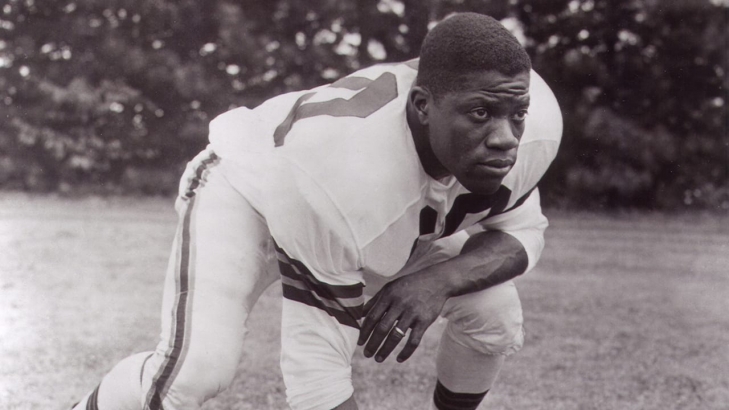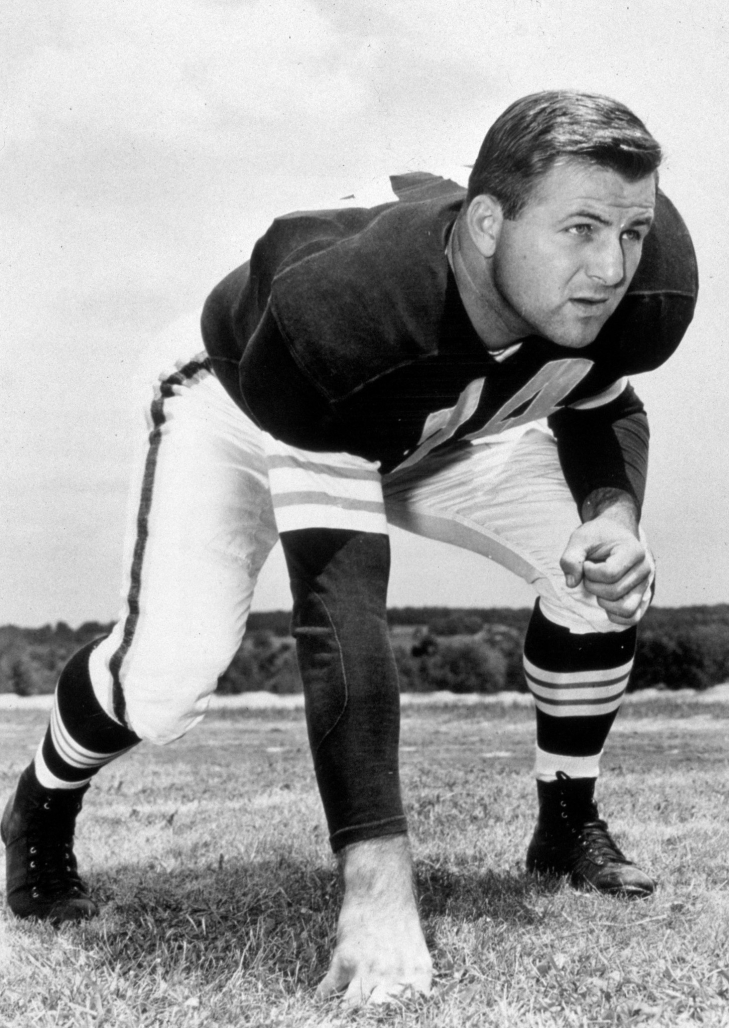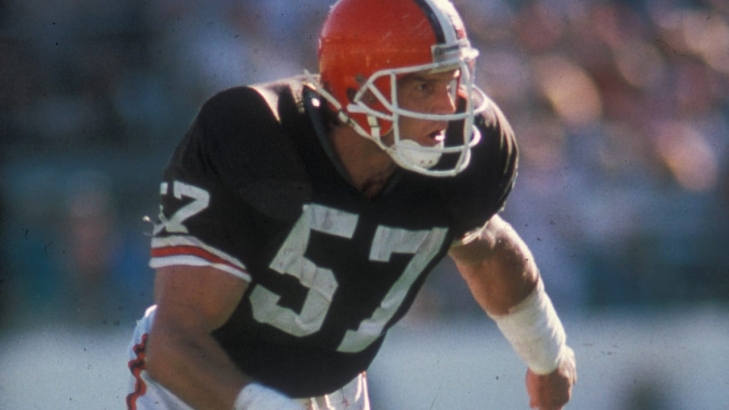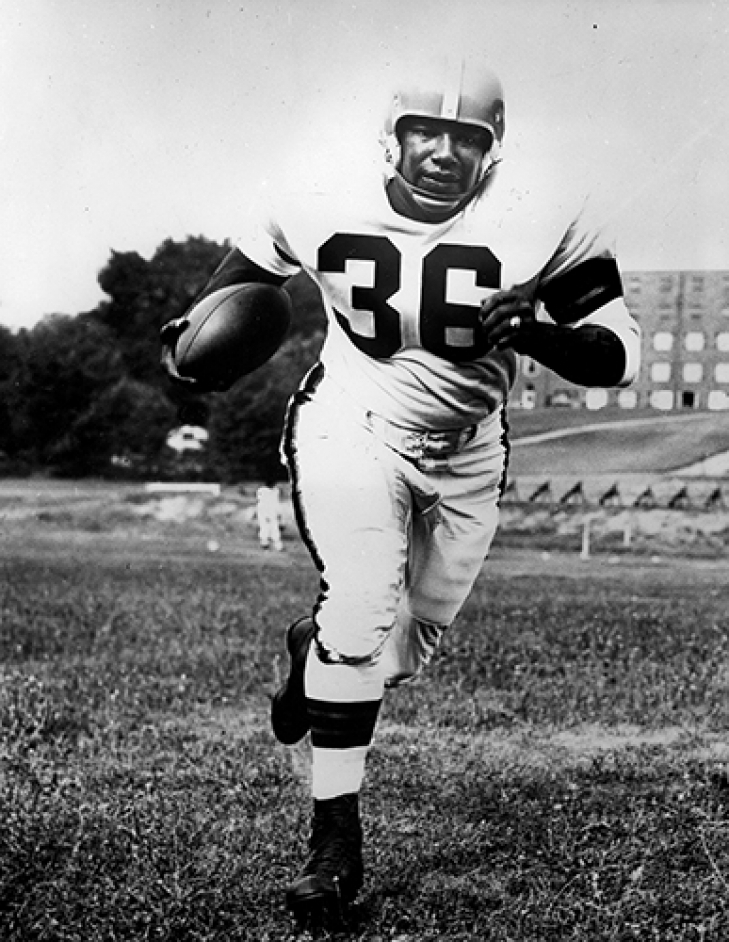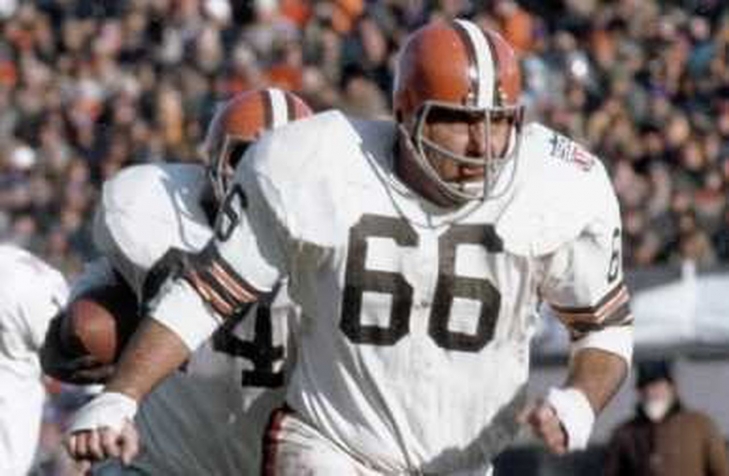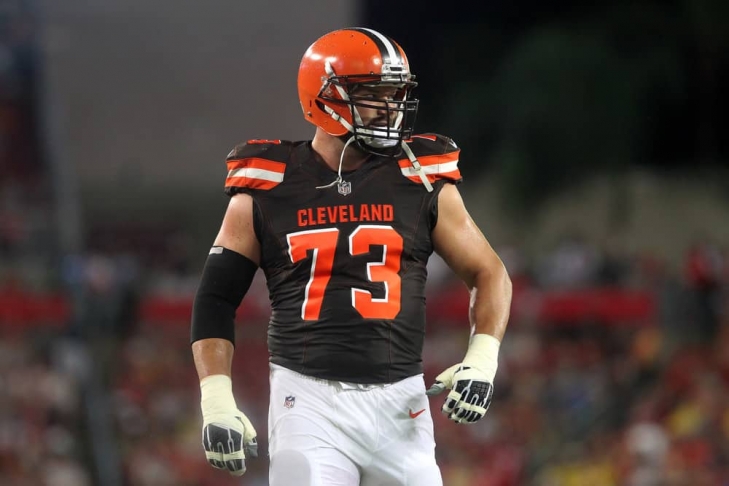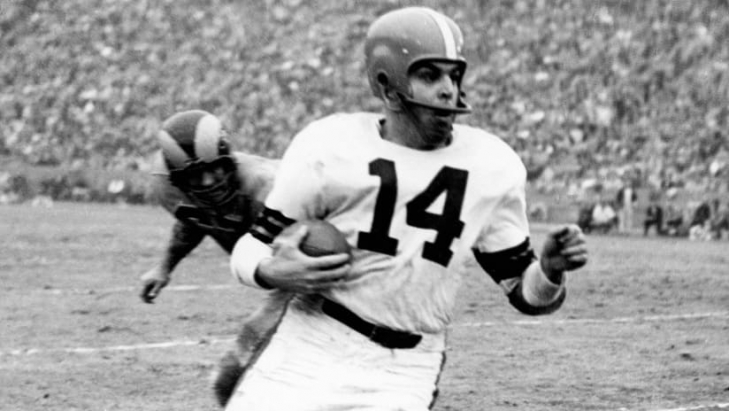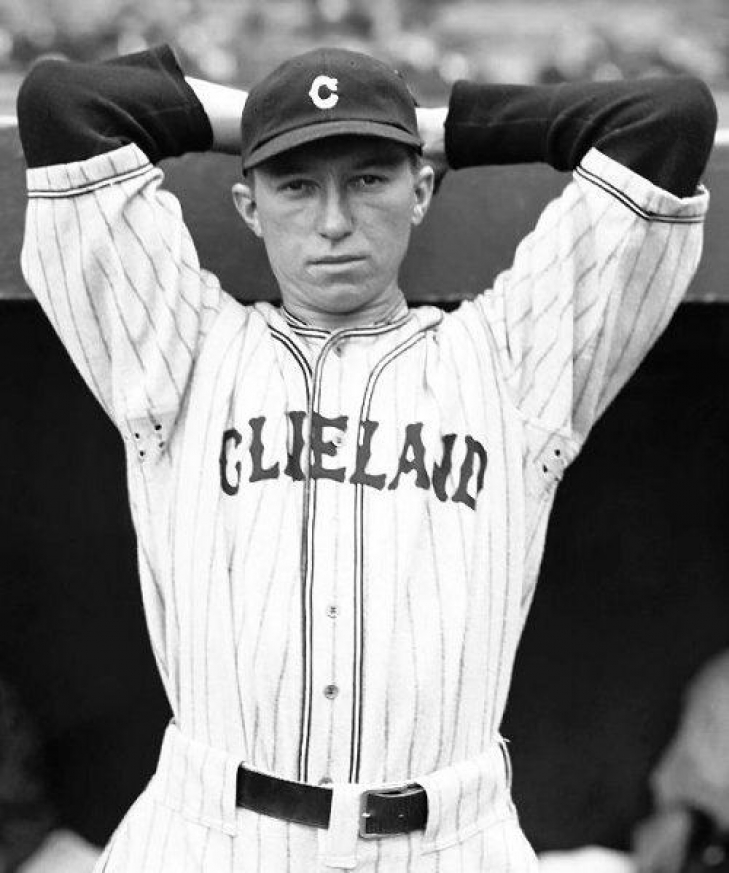16. Bill Willis
Bill Willis played for Paul Brown at Ohio State, where he was a part of the 1942 National Championship Team. Willis graduated in 1945 and wanted to play pro football, but as a black man with the knowledge that the NFL had an unspoken rule about African-Americans, there was nowhere for him to go.
Enter the All-American Football Conference.
In 1946, his former Head Coach, Brown, was the Head Coach of the new team that bore his name, and Willis received an opportunity to try out for the Cleveland Browns. Willis made the team, and along with Marion Motley, were among the first two black players in pro football.
Playing at Guard, he was a part of the Browns dominance of the short-lived league, winning all four Championships. Willis proved to be one of the top Guards in the AAFC, especially on the defensive side of the ball. When the AAFC migrated with the NFL, Willis was recognized as a three-time Pro Bowl and three-time First Team All-Pro. The Browns won the 1950 NFL Championship, and Willis was a colossal component of Cleveland's success in their early existence.
Willis retired in 1953, and the Pro Football Hall of Fame called his name for induction in 1977. The Browns also chose Willis for their Ring of Honor in 2010 as part of the first group.
15. Paul Warfield
Paul Warfield was a National Champion at Ohio State in 1961, an All-American in 1963, and would stay in the state as a professional football player when the Cleveland Browns used the 11th Overall Pick to select the End.
Warfield joined an already potent Cleveland offense, led by Jim Brown. He was immediately plugged into the scheme, accumulating 920 Yards as a rookie and helping Cleveland win the NFL Championship. The Browns returned to the Title Game in 1965, though he missed nearly the entire season due to a broken collarbone.
He returned healthy in 1966 and was back to his old self, earning Pro Bowls in 1968 and 1969. He would lead the NFL in Rushing Touchdowns in 1968 (12) and had ten the year after. Warfield was an upper-tier Receiver, but the Browns inexplicably thought he was nearing the end, and they dealt him to Miami for only a Third Round pick in return. Warfield got even better and would win two Super Bowls with the Dolphins. After one year with the Miami Southmen of the World Football League, he returned to the Browns in 1976, playing two more years before retiring.
Warfield caught 271 passes for 5,210 Yards and 52 Touchdowns with Cleveland and was inducted into the Pro Football Hall of Fame in 1983. He would later receive another prestigious accolade when he was named to the NFL 100thAnniversary Team. Warfield was also inducted to the Browns Ring of Honor as part of the first group in 2010.
14. Len Ford
A National Champion at Michigan in 1947, Len Ford signed with the Los Angeles Dons of the AAFC, but the Dons were not one of the teams that would be absorbed into the NFL when the two leagues merged after the 1949 Season. The Cleveland Browns took Ford in the Dispersal Draft, who was one of the teams that the NFL did take and who won all four AAFC Titles.
Ford, who was more of a two-way End in L.A., was predominantly used on defense in Cleveland, and he aided the Browns in their 1950 NFL Championship Team. Ford become one of the best Defensive Ends in the game, and he was chosen for four straight First Team All-Pros and Pro Bowls (1951-54) and would later be named to the 1950's All-Decade Team. He was also integral in Cleveland's 1954 and 1955 NFL Championships.
He played with the Browns until 1957 when he was traded to Green Bay, where he played one final year.
Ford was inducted into the Pro Football Hall of Fame in 1976 and was an inaugural member of the Browns Ring of Honor in 2010.
17. Mike McCormack
Mike McCormack played for the New York Yanks as a rookie, but he would leave them to serve his country in the Korean War. When he returned, the Yanks had folded, and the Baltimore Colts were created to replace them. McCormack signed with the Colts, but Cleveland Browns Head Coach, Paul Brown, remembered the Lineman and traded for him before he played for the Colts.
McCormack started at Middle Guard and then Right Tackle, helping Cleveland win the NFL Championship in both 1954 and 1955. The Browns were a very competitive team for McCormack's duration (until 1962), and he was named to five Pro Bowls and three Second Team All-Pros. Brown had referred to McCormack as the best Lineman that he ever coached, and that is as high praise as you can get. The Browns agreed and named him to their Ring of Honor in 2010.
13. Clay Matthews Jr.
From USC, Clay Matthews Jr. was the son of a four-year NFL vet, Clay Matthews Sr., and the brother of Bruce Matthews, who would enter the Pro Football Hall of Fame. Clay Jr. did not make it to Canton, but many in Cleveland feel that he should have.
Matthews Jr. was taken in the First Round in 1978, and in his sophomore year, he was a starter at Outside Linebacker. Leading the NFL in Tackles four times, the former Trojan was also a four-time Pro Bowler and had eight seasons where he cracked the 100-Tackle mark. An expert run-stuffer, Matthews Jr. was a durable figure who played for Cleveland from 1978 to 1993, playing in 232 Games.
He left Cleveland for Atlanta, where he played three more seasons before retiring at age 40. As a Brown, Matthews Jr. would have 62.0 Sacks and 1,420 Tackles, and in 2019, he was inducted into the Browns' Ring of Honor.
12. Mac Speedie
Mac Speedie played collegiately at Utah and was a late-round pick (15th) in the NFL Draft. He did not enter the NFL, opting instead to go to the military to serve the United States in World War II, and when he returned, he tried out and made the Cleveland Browns of the upstart All-American Football Conference.
Browns' Head Coach, Paul Brown, used Speedie in his offense at End, where he would become one of the top receivers in the AAFC. Speedie and the Browns won all four titles in the AAFC’s existence, and Speedie was the league leader in Receiving Yards twice.
The Browns migrated to the NFL in 1950, and he was named to the Pro Bowl twice, though he was unable to reach the four-digit mark in Receiving Yards as he did in the AAFC. He did, however, help Cleveland win the NFL Championship in 1950, which was his fifth in a row.
His run in the NFL could have been longer, but a dispute with Brown resulted in Speedie taking his talents to Canada, where he played three years before retiring. Speedie had 5,602 Yards with 33 Touchdowns with Cleveland.
Speedie was elected to the Pro Football Hall of Fame as part of the Centennial Class. That year, Speedie entered the Browns' Ring of Honor.
11. Dante Lavelli
Dante Lavelli played for Paul Brown at Ohio State, where the duo won the National Championship in 1942. Lavelli entered the U.S. Military in World War II, and when the conflict ended, he rejoined Brown, who built the Cleveland Browns of the new All-American Football Conference.
Along with Mac Speedie, Lavelli was a star at End who led the AAFC in Receptions (40) and Receiving Yards (843 in the league's first year. Lavelli was a consistent producer and excellent blocker, and he was a large part of why Cleveland won all four AAFC Titles. Cleveland was one of the teams that joined the NFL when the AAFC merged with the senior league, and they continued to dominate, winning the NFL Championship in 1950, 1954, and 1955. In the NFL era, Lavelli was a three-time Pro Bowler and was an instrumental cog in Paul Brown's machine.
Lavelli was enshrined in the Pro Football Hall of Fame in 1975 and was named to the first group of former players to the Browns Ring of Honor in 2010.
10. Leroy Kelly
We can't even imagine what it must have been like for Leroy Kelly to follow in the footsteps of Jim Brown.
Realistically, who could?
Despite this, Kelly, who was taken in the NFL Draft in 1964, was initially Brown's understudy and assumed the starting role when Brown shockingly retired. Kelly thrived, going to six straight Pro Bowls (1966-71) and winning the Rushing Title twice (1967 & 1968). Kelly also led the NFL in Rushing Touchdowns in three consecutive seasons (1966-68), and while his production was not equal to Brown, whose was?
Kelly rushed for 7,274 Yards and 74 Touchdowns on the ground, which for his era, was very impressive.
He entered the Pro Football Hall of Fame in 1994, and in 2010, Kelly was part of the first group of Browns to be named to the Ring of Honor.
9. Frank Gatski
Paul Brown knew that Otto Graham would be the player he built his team around and quickly adopt Marion Motley as another offensive stud. The man who helped stir that drink was an unexpected player named Frank Gatski.
Gatski played college football at Marshall and then enrolled in the American military during World War II. Following the war, Gatski tried out and made the Browns in their inaugural season of the AAFC. Gatski, or "Gunner" as he was known, opened the holes for Motley and expertly protected Graham for years. Easily the best Center in the AAFC, he helped Cleveland win all four Championships and proved his worth in the NFL as the Browns won the NFL Championship in their first year after the NFL-AAFC merger.
Gatski, who was so good, that he never botched a snap over his entire career, helped the Browns win the 1954 and 1955 Championship, and in his last year in the NFL, 1957, he was with Detroit and won an eighth title. The Browns inducted Gatski to their Ring of Honor as part of the inaugural group in 2010.
8. Marion Motley
While there were African Americans in pro football before Marion Motley, they had been phased out, but this was about to change after World War II. Motley tried out for the Cleveland Browns of the new All-American Football Conference, and he made the team and would become of the best players in team history.
Motley was an excellent rusher who won the AAFC Rushing Title in 1948 and the NFL Rushing Title in 1950, and he was a large part of the Cleveland juggernaut that won all four AAFC Championships and the 1950 NFL Championship. He was also incredibly valuable as a blocker and helped open up Otto Graham's passing game.
Motley had 5,827 Yards From Scrimmage, an excellent total for his era. In 2010, Motley was part of the first group of former Browns named to their Ring of Honor.
6. Gene Hickerson
From Ole Miss, Gene Hickerson was chosen in the Seventh Round in the 1957 Draft, where Cleveland Browns Head Coach, Paul Brown, liked his speed and moved him to the Right Tackle position, where he became their starter in his second season. As Hickerson improved, his 1961 Season was taken from him due to a broken leg, but he returned the following season as a greater asset that protected Jim Brown and company.
Hickerson helped Cleveland win the 1964 NFL Championship, and as he turned 30, he defied time and grew into one of the top Guards in football. From 1965 to 1970, Hickerson put forth an Approximate Value of at least 11, peaking with 18 in 1968. In all of those six years, Hickerson went to the Pro Bowl and was a First Team All-Pro from 1967 to 1969. Hickerson played until the end of the 1973 Season, and he retired with the team he started with, finishing with 202 Games Played.
Hickerson received the Pro Football Hall of Fame call in 2007. Three years later, he was part of the first Browns Ring of Honor class. Notably, Hickerson was also named to the 1960s All-Decade Team.
5. Ozzie Newsome
At the time of his retirement, many felt that Ozzie Newsome was one of the most prolific Tight Ends in football history, and some say he still is.
Taken in the First Round (23rd Overall) out of Alabama, Newsome brought his blocking and receiving skills to the Browns in 1978. Known for his cerebral play, Newsome helped take the Browns to two AFC Championship Games, and he would have three 1,000-Yard seasons, which were excellent for a Tight End in the 1980s. Newsome played his entire career with Cleveland, accumulating 7,980 Yards with 47 Touchdowns.
Newsome was elected into the Pro Football Hall of Fame in 1996, his first year of eligibility, and was part of the first class of the Browns Ring of Honor in 2010. As an executive, he orchestrated teams that won two Super Bowls when the franchise relocated to Baltimore.
7. Dick Schafrath
Backs. The Cleveland Browns of the 1960s had some of the best runners, and Dick Schafrath was a big reason they found as much opportunity to run as they did.
Stepping in from Ohio State, Dick Schafrath maintained the high-level coaches expected at that position. He protected the weak side brilliantly but used his robust frame to create holes for Cleveland's backs. In fact, on eight occasions, Cleveland Browns' Running Backs won the rushing title with Schafrath anchoring the left side.
As a four-time First Team All-Pro, it is a little curious that he hasn't received a look from the Hall, but he doesn't need the accolade to complete his existence with the excellent post-football life he led.
Schafrath was named to the Browns Legends list in 2003.
4. Lou Groza
An original Cleveland Brown, Lou Groza was recruited by Paul Brown, primarily to act as the Browns’ Place Kicker. Groza led the AAFC in Points in his rookie year, and after two seasons, Groza also helped out on Cleveland’s Offensive Line, and he would perform a dual-role for the next twelve seasons.
The Browns won the first four AAFC Championships, and Groza helped them win the 1950, 1954, and 1955 NFL Titles. Groza evolved into an above-average Left Tackle, but his kicking talents were ahead of its time. "The Toe" was one of the first Kickers who could regularly get it through the uprights in further distances. Before Groza, Field Goals beyond 40 Yards were rarely attempted, but a new dynamic was added to the game with Groza as a weapon. He would be named a First Team All-Pro four years in a row (1952-55) with nine Pro Bowl appearances. Back issues compounded, and he retired after the 1959 Season.
Groza came out of retirement in 1961, rejoining Cleveland but only as their Kicker. For the fourth and fifth time, Groza led the NFL in Field Goal Percentage and helped the Browns win the 1964 Championship, making him the only player to win seven titles with Cleveland. He retired for good after the 1967 Season.
Graham entered the Pro Football Hall of Fame in 1974, and his number 76 is one of five retired by the team. He was also part of the inaugural Browns Ring of Honor in 2010. Groza is also a member of the 1950s All-Decade Team.
3. Joe Thomas
The second incarnation of the Cleveland Browns had a bad start. Going one step further, there is no inaccurate negative pejorative you could use to describe their first 20 years. One thing they universally did perfectly was select Joe Thomas with the Third Overall Pick in the 2007 Draft.
Thomas, who won the Outland Trophy in 2006 with Wisconsin, was an All-Rookie and Pro Bowler at Left Tackle, and he did not miss a play as a rookie. That is impressive enough, but he never missed a snap until the 2017 season, participating in 10,363 consecutive, a record, although that was not recorded until 1999.
Thomas was not just an iron man; he was outstanding at what he did. He was named to six First Team All-Pros and was a Pro Bowler annually from his rookie season (2007) to 2016. An innovator with his shotput style in pass blocking, Thomas was hard for defenders to figure out. He rarely allowed a sack, and even less was called for holding.
Named to the 2010s All-Decade Team, Thomas's Browns teams only won 48 Games to 128 Losses. It is an abysmal record, but where would they have been without him?
Thomas is considered to be one of the best Left Tackles in the history of the game. He was named to the Browns Ring of Honor in 2018.
2. Otto Graham
We believe Jim Brown is the greatest Cleveland Brown of all time, but it was Otto Graham who was the first team legend.
Playing for Northwestern, Graham was the Big Ten Player of the Year in 1943, and he was third in Heisman voting. Following his career as a Wildcat, Graham enrolled at Colgate for flight school, and he continued to participate n athletics, mainly basketball.
Paul Brown was putting together a football team for Cleveland in the new All-American Football Conference, and he looked to Graham to be the centerpiece of his new squad. In the four years of the AAFC's existence, Graham was arguably the league's best player, as the Quarterback meshed perfectly with Brown's offensive vision. Cleveland won all four of the AAFC Championships (1946-49), with Graham leading the league in Passing Yards the last three years. Going into the 1950 Season, the AAFC merged with the NFL, with the Browns being one of the surviving teams. Few people thought they would repeat their success as an NFL team. Graham had other ideas.
Graham took Cleveland to an NFL Championship in 1950, and the QB was now five-for-five. He continued to be one of the top QBs in the first half of the decade, winning two passing titles (1952 & 1953) and earning three UPI MVPs (1951, 1953 & 1955). Graham again led the Browns to two more titles (1954 & 1955), and he retired after the 1955 Season, having won seven titles in ten years.
Graham entered the Pro Football Hall of Fame in 1965, and his number 14 was retired by the team. He was also part of the inaugural Browns Ring of Honor in 2010. The NFL also named Graham to the 1950s All-Decade Team and the 75thand 100th Anniversary Team.
1. Jim Brown
Jim Brown is a football god.
We could end it here, but out of deference to the man we think is not only the most outstanding rusher in the history of the game but the best offensive player ever, we will go through all the reasons why Brown is the best player in franchise history.
An absolute beast at Syracuse, Cleveland was fortunate that Brown was still available with their Sixth Overall Pick in the 1957 Draft. Brown was an instant star in the National Football League, winning the Rushing Title as a rookie and the Offensive Rookie of the Year and MVP. Brown had a signature moment, rushing for a then-record 237 Yards, which stood tall for 14 years.
As Brown’s second year approached, expectations were high, and the Fullback not only met them, he shattered them. Brown rushed for 1,527 Yards, destroying the record, and remember this was done in a 12-game season. He also had a career-high 17 Touchdowns.
Brown played until 1965, and every single year was his gridiron world; everyone else was living in it. Playing nine seasons (all with Cleveland), Brown was a Pro Bowl in all of them and an eight-time First Team All-Pro and eight-time Rushing Title winner. Even in the season, he did not win the Rushing Title (1962); he had career-bests in Receiving Yards (517) and Receiving Touchdowns (5). It is not a miscalculation to say that Brown's ability and playing style changed the game of football forever.
In addition to his MVP as a rookie, Brown won two more (1958 & 1965) and arguably could have won more. While the Browns only had one NFL Championship when he was there (1964), Cleveland went to two more Title Games (1957 & 1965), and his mere presence made the Browns an annual contender.
Perhaps the most impressive stat is that Brown had a career Approximate Value of 121 in 118 Games. Only an elite player can average more than one AV/Game, but remember that Approximate Value was not calculable until 1960, meaning that his 121 AV is only through 82 of his Games!
Brown easily could have continued his career, as he was not yet 30 and was coming off another MVP, but he retired after the '65 campaign and sought a career in Hollywood. He had 12,313 career Rushing Yards, which at the time was easily the most ever. Several players have surpassed Brown since then, but they all needed many more games to do it.
Brown entered the Pro Football Hall of Fame in 1971, and he was named to the 1960s All-Decade Team and 50th, 75th, and 100th Anniversary Teams. Brown's number 32 was retired by the team, and he was named to their Ring of Honor as part of the first group in 2010.
#46 Overall, Joel Bitonio, Cleveland Browns, Left Guard, #8 Offensive Lineman
2023 Pre-Season Rank #60, 2022 Pre-Season Rank #91, 2021 Pre-Season Rank #143. Peak Period: 2018-22
Bitonio is now on a six-year run of Pro Bowls, and two years ago, he put forth his best campaign to date with his second First Team All-Pro nod. No other Offensive Linemen have risen more over the last two seasons than the guard, who has been Cleveland's most consistent figure in the past six years.
#84 Overall, Nick Chubb: Cleveland Browns, #5 Running Back
2023 Pre-Season Rank #91, 2022 Pre-Season Rank #114, 2021 Pre-Season Rank #140. Peak Period: 2018-22
Chubb emerged as the top rusher for an improving Browns offense and was a perennial Pro Bowl Selection from 2019 to 2022. He likely would have been again last year, but he tore his ACL in Week 2 and is not expected back until October. If Chubb returns to what he was, he can reclaim that HOF momentum.
9. Mel Harder
A Cleveland Indian for his entire career, Mel Harder debuted for the Tribe in 1928, where he was used in relief in his first two seasons when he was on their main roster and not in the minors.


